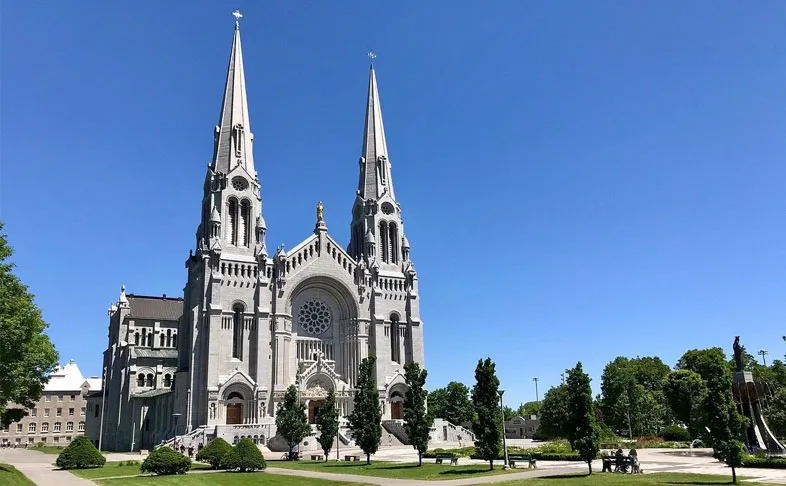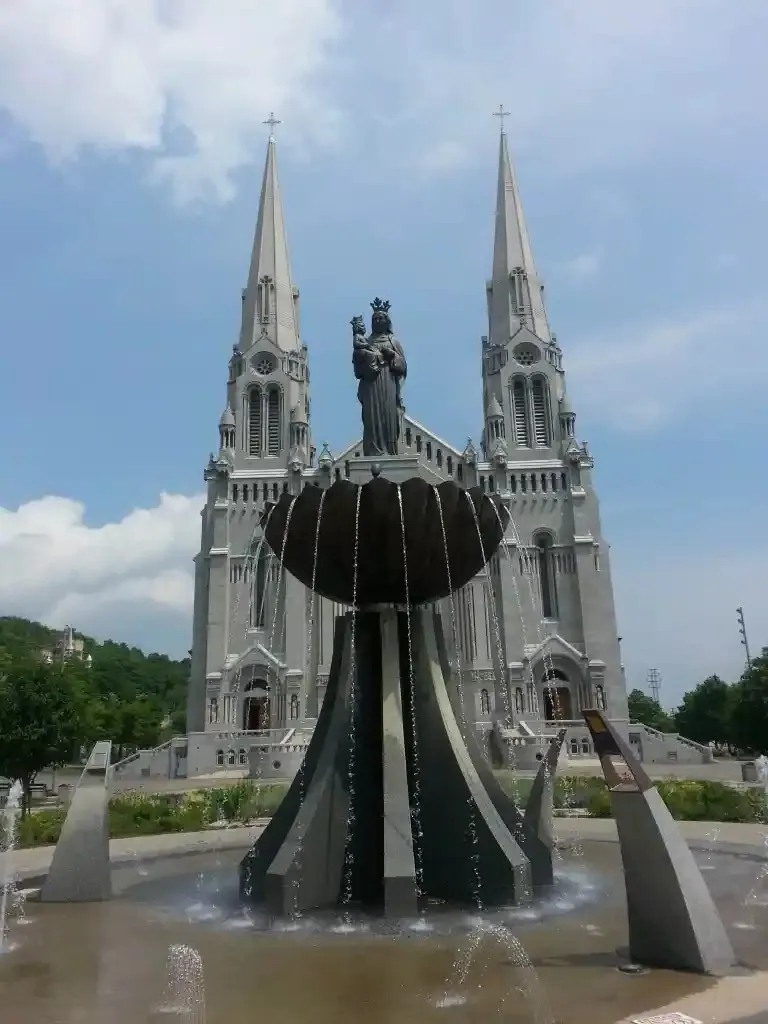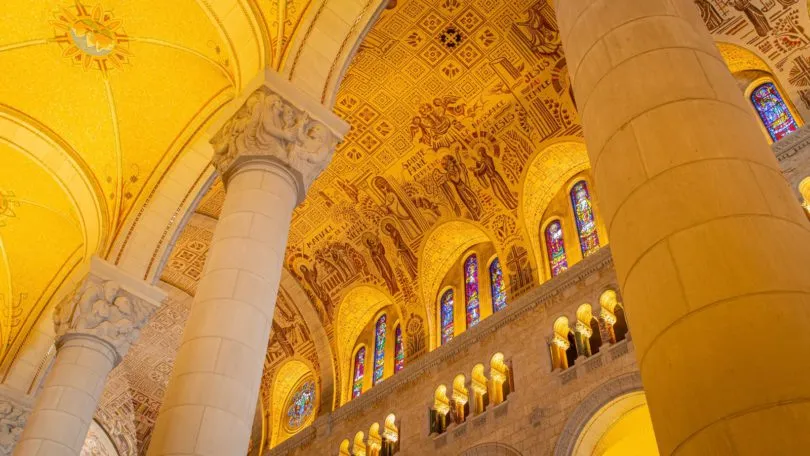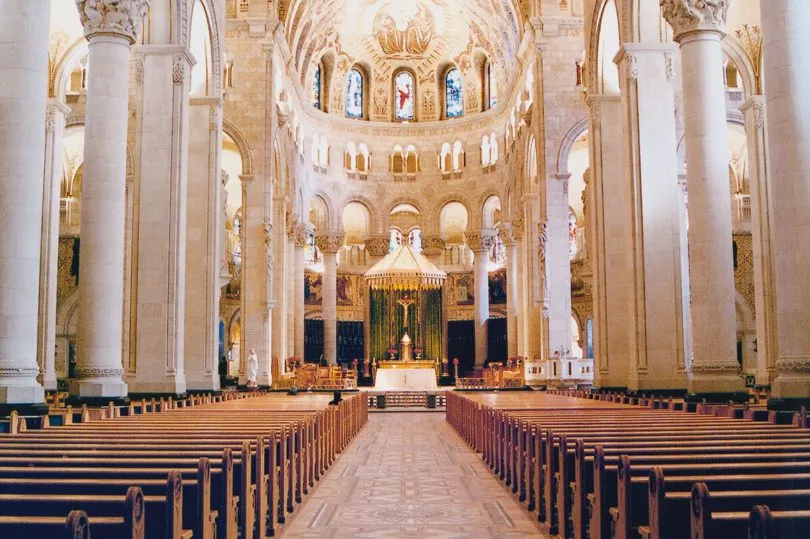
Introduction
The Basilica of Sainte-Anne-de-Beaupré (French: Basilique Sainte-Anne-de-Beaupré) is along the Saint Lawrence River in Quebec and provides its guests with breathtaking views from every angle. The Sainte-Anne Basilica is not just one of the eight national shrines in Canada; it’s also one of the oldest pilgrimage sites in North America.
The Shrine of Saint-Anne-de-Beaupré serves as a pilgrimage site. It is a significant Catholic safe-haven, which gets about a half-million explorers every year. The pinnacle time of journey is around July 26, the feast of Holy person Anne, the patron saint of sailors. Not only does this basilica exude an obvious amount of beauty, but it’s said to be filled with many miracles!
The Shrine has been welcoming people from all walks of life for over 350 years. The Basilica of Sainte-Anne-de-Beaupré has artful stained glass windows, mosaics, and sculptures. The basilica also contains relics (specifically bone fragments) said to belong to St. Anne, the mother of the Virgin Mary and grandmother of Jesus Christ.

On March 8, 1658, settler Étienne de Lessard donated two frontal acres from the west end of his property to the Catholic Church, so that a chapel could be built. This chapel eventually became the site of the modern-day basilica. The chapel was built to provide a place of worship for the new settlers in the area and to house a miraculous statue of St. Anne. The first reported miracle at the site happened during the shrine’s construction.
A man named Louis Guimont was recruited to assist with building the sanctuary despite the fact that he experienced stiffness. Subsequent to putting three stones upon the hallowed place’s establishment, Guimont was relieved of all his ailments. This was trailed by different declarations of recuperated individuals, and the altar before long filled in fame. Numerous pioneers came to the hallowed place expecting to get a wonder while others, similar to Anne of Austria, spouse of Louis XIII and Sovereign of France, upheld the sanctum from a distance. Due to the fame of the sanctuary, the structure was developed a few times to oblige every one of the travellers. In the late nineteenth 100 years, a basilica was developed around the place of worship. In 1876, the primary basilica opened for love.
This was obliterated in a fire on Walk 29, 1922. The present-day basilica was underlying 1926 on the site of the earlier church. Architect Maxime Roisin, Louis N. Audet and Joseph-Égilde-Césaire Daoust teamed up on the venture from 1923 to 1931. After the finish of the Economic crisis of the early 20s, work on the inside continued in 1937, and was at last finished in 1946.
Explorers are drawn in from across Canada and the US. Wonders are as yet accepted to happen at the basilica. Two support points close to the entry are loaded up with racks of bolsters, sticks, supports, and different indications of inabilities. Everything has been left by pilgrims who reports being recuperated at the basilica.

The Basilica was completed to be constructed in1963 in the 12th century. It has the Romanesque gothic style. The saintee- Anne- de- Beaupré can accommodate 9000 worshippers. This building is in Romanesque Revival style and built in the shape of a cross.The Basilica is approximately 100 metres high, from the floor to the top of the bell towers.It is about 60 metres wide at the transept crossing and 50 metres at the façade.The building extends about 100 metres in length.
The entire ceiling mosaic of the Basilica describes the life of Saint Anne. It tells the story of her life, the life of a Jewish woman of that era. It speaks of her virtues, which by the way should be ours too. The vault also illustrates her glorification to us.
At the heart of the apse, just above the main altar, we see Saint Anne, the Virgin Mary and the child Jesus. Saint Anne is giving a fruit to Jesus; which is not just a treat from a grandmother to her grandson; it is a marvelous symbol of His Mission as the Redeemer and Saviour of Humanity. It is not a Fruit of Death, like the fruit that Adam and Eve ate, but a Fruit of Life saving us from original sin.
The main doors of the Basilica are hand-made of copper and they present many scenes of the life of Jesus. This exceptional work of art created by the artist Albert Gilles was originally hanging on the doors of the St. Joseph Church in Quebec City in the 1950’s. The three double doors alone represent 12 months of laborious work. After the closing of this church in 2003, Albert Gille’s masterpiece was given a second chance at life when it was transferred to the Saint Anne de Beaupré Basilica the same year, to the great benefit of pilgrims and visitors. Above the three main doors, the Father Creator, the Son Redeemer and the Holy Spirit are represented.
At the peak, between the two bell towers, you can find the statue of Saint Anne which was saved from the destructive fire of the first Basilica in 1922. This statue of Saint Anne was from the first constructed basilica which survived the fire.
Immaculate Conception Chapel

In the lower floor of the Basilica a beautiful chapel dedicated to Mary, the Immaculate Conception, the daughter of Saint Anne is built which is a way of glorifying the grandmother of Jesus. With a typical Romanesque architecture, the chapel is decorated with paintings, some by Frédéric Doyon and others by Marius Dubois. There are 176 small mosaics that can be admired. The mosaics represent birds, flowers, butterflies, all small things but so pretty, reminding once again of all nature, creation of a generous God who shows us his love through all these beauties.
Relics

The Shrine has in its possession three notable relics. The first relic (a portion of the bone of Saint Anne’s finger) was brought in by the Carcassonne Chapter, and was brought to the Shrine on March 12, 1670, by Bishop François de Laval.
The first major relic arrived at the Shrine on July 26, 1892, as a gift from Pope Leo XIII. It’s a 4- inch portion of the bone of Saint Anne’s forearm. It was got from the Basilica of St. Paul Outside the Walls, in Rome, and was brought to Saint Anne de Beaupré by Bishop Joseph- Calixte Canac- Marquis (1821 – 1904).
Eventually, on July 3, 1960, another MAJOR RELIC of Saint Anne (also from her forearm) was brought to the Shrine from The Basilica of St.Paul Outside the Walls, this time, as a gift from Blessed Pope John XXIII
Ambulatory Chapels
The basilica is surrounded by 10 different chapels. Each Chapel is dedicated to a different Saint that has made a significant contribution in the Church. The ten saints are
- Saint Alphonsus, founder of the Congregation of the Redemptorists
- Our Lady of Perpetual Help, whose devotion is entrusted to the Redemptorists
- Saint Patrick, in honour of the numerous Irish pilgrims
- Saint Joseph, the son-in-law of Saint Anne
- Saint Benedict, a spiritual leader, founder of the Benedictines, the origin of all religious congregations
- Saint John Baptist de la Salle, educator and founder of Christian schools
- Saint Joachim, husband of Saint Anne
- Saint John the Baptist, patron of French Canadians
- Chapel of the Blessed Sacrament, Chapel of the Reserve Tabernacle
- Saint Gerard Majella, Redemptorist brother, a remarkable Saint
The beautifully decorated Chapels surrounding the Sanctuary were built before the Second Vatican Council, at a time when each Priest would celebrate daily Mass on an individual basis. Above all the Chapels is a large mosaic illustrating the history of the Eucharist in the Church. This mosaic extends around the Sanctuary as a crown above the ten Chapels.
Memorial Chapel
The Memorial Chapel is a souvenir of the third church which welcomed pilgrims from 1676 to 1876.The chapel was built in 1878 on the foundation of the transept of the third church (1676-1876).The material, the decor and the steeple were all retrieved from the old church and incorporated into the construction of the Memorial Chapel. A rooster weather vane, a symbol of Peter’s denial as a follower of Christ, pivots on top of the steeple.The adjacent cemetery was where parishioners were buried until 1930.
Scala Santa
The “Scala Santa” is the staircase that Jesus ascended to Pilate’s praetorium. It is therefore a precious reminder of the Passion. In the last century it became more customary, in several places of the Catholic world, to build staircases that exactly replicate the Scala Santa of Rome.
This replication is followed at Sainte-Anne-de-Beaupré, where in 1891 the first monument of this type in America was erected. In each of the staircase’s risers a souvenir from different shrines from the Holy Land was inserted. The Holy Stairs themselves are located inside the building, on the second floor.
Way of the Cross
The Way of the Cross depicts the path scene of the way Jesus carried his cross. Fourteen stations evoke different moments of the Passion of Jesus. It is an old but never exceeded devotion. The basilica of Sainte-Anne-de-Beaupré has this way of cross.
Each scene includes about five persons in cast bronze, cast in the workshops in Vaucouleurs, France. Construction of this Way of the Cross was spread over a long period, from 1913 to 1945.
The Pietà
One of the best replicas of Michelangelo is found here. It’s much more than a work of art.Many pilgrims find courage, strength and hope in it. The original Michelangelo’s statue – the pieta is in Rome.
Saint Anne's Fountain
Before the basilica, a lovely fountain invites pilgrims.Introduced in 2008, for the festival of the 350th commemoration of the basillica, this fountain arrives at a level of ten meters. Water streams over the scalloped lips of a bronze bowl of nearly 4 meters in breadth. At the culmination is a sculpture addressing St.Anne and her girl Mary.
This sculpture is crafted by Mr. Émile Brunet. It addresses st. Anne showing the Virgin Mary, with Mary holding a look with “Caritas”, Latin for charity.
Mr. Brunet once shared that the expression on Saint Anne’s face is one of “meekness and kindness” and that “Saint Anne would be about 45 years of age and the Virgin, three”. He didn’t ignore the fact that this statue would stand on Canadian soil: “Since Saint Anne’s statue will be set up in Canada, I thought the Canadian spirit would require a crown of maple leaves to be made as a tribute to Saint Anne and the Holy Virgin”. (Émile Brunet, 1958)
Feast Day
The feast day Basilica of Sainte Anne de Beaupre, Quebec, Canada is celebrated on 26th July of every year which is also the feast date of St. Anne.
Mass Timing
Sunday : 8:00 a.m, 9:30 a.m, 11:00 a.m, 4:30 p.m.
Basilica Rosary : 10:30 a.m.
Monday, Wednesday, Friday : 6:30 a.m.
Basilica Rosary : 11:00 a.m.
Basilica Mass: 11:30 a.m.
Tuesday and Thursday
Blessed Sacrament Chapel Mass (Live on Shrine Website): 6:30 a.m.
Basilica Rosary: 11:00 a.m.
Basilica Mass: 11:30 a.m.
Holy Hour (Basilica): 2:00 p.m.
Saturday
Blessed Sacrament Chapel Mass (Live on Shrine Website): 6:30 a.m.
Basilica Rosary: 11:00 a.m.
Basilica Masses: 11:30 a.m, 4:00 p.m.
Contact Info
10018 Avenue Royale,
Sainte-Anne-de-Beaupré Qc,
G0A 3C0, Canada.
Phone No.
Phone: 418-827-3781 / 418-827-8771
Accommodations
How to reach the Sanctuary
Airport
The nearest airport to Basilica of Sainte-Anne-de-Beaupré is Quebec (YQB) Airport which is 43.2 km away from the basilica.
Railway
The nearest railway station to Basilica of Sainte-Anne-de-Beaupré is Gare du Palais railway station which is 34.1 km away from the basilica.







